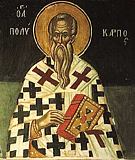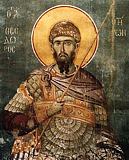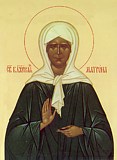

| Previous day | Next day |
| Old Style
February 23
|
Saturday |
New Style
March 7
|
|
1st Week of Great Lent.
Tone 4.
Great Lent. |
Wine and oil allowed.
|
![]() Commemoration of St. Theodore the Tyro (ca. 306).
Commemoration of St. Theodore the Tyro (ca. 306). ![]() Hieromartyr Polycarp, bishop of Smyrna (167). Finding of the Relics of St. Matrona of Moscow (1998)
Hieromartyr Polycarp, bishop of Smyrna (167). Finding of the Relics of St. Matrona of Moscow (1998)
St. Alexander, founder of the Monastery of the Unsleeping Ones, Constantinople (ca. 430). Sts. John, Antioch, Antoninus, Moses, Zebinas, Polychronius, Moses (another), and Damian, ascetics near Cyrrhus (5th c.). St. Polycarp, monk, of Bryansk (1620-1621). St. Nazarius, abbot of Valaam Monastery (1809). St. Seraphim (Zenobius), schema-metropolitan of Tetritskaro, Georgia, monk of Glinsk Monastery (1985).
New Hieromartyr Michael Edlinsky, archpriest, of Kiev (1938).
St. Gorgonia (372), sister of St. Gregory the Theologian. St. John Theristes (the Harvester) of Stylos in Calabria (11th c.). St. Damian of Esphigmenou, Mt. Athos (1280). St. Cosmas of Zographou, Mt. Athos (1281). St. Moses, monk of White Lake (1480). New Monk-martyr Damian of Philotheou and Kissavos, at Larissa (1568). New Hieromartyr Lazarus of the Peloponnese (ca. 1618).
Repose of Archimandrite Agapit (Belovidov) of Optina Monastery (1922) and Elder Sabbas (Stavrobouniotes) of Cyprus (1985).
Thoughts for Each Day of the Year
According to the Daily Church Readings from the Word of God
By St. Theophan the Recluse

Saturday. [Heb. 1:1–12; Mark 2:23–3:5]
We have approached the chalice of the Lord, we have been at the Supper of the Lord. Glory to Thee, O God! Glory to Thee, O God! Glory to Thee, O God! Now is the great day of the Lord! The most glorious celebration in heaven! There is no city, nor village, nor house, where there are no people receiving Holy Communion. Across the breadth of Russia, throughout the south and east, so many people clothed in the white garments of justification have tasted of the Divine life, and have most sincerely united themselves with the Lord! The Lord’s Body has been renewed—the Body of the Church, and has been clothed in the glory belonging to it, hidden from the eyes of man, but visible to the eyes of angels. The angels worshipped the First-born when He was brought to the world in His power; now they have worshipped Him because the world has been brought again to Him. They have worshipped Him and sung out: Thy throne, O God, is for ever and ever: the sceptre of Thy kingdom is a right sceptre; Thou lovest righteousness, and hatest wickedness (Ps. 45:6–7).
Articles
 Greatmartyr Theodore the Tyro (“the Recruit”)In memory of this occurrence, the Orthodox Church annually celebrates the holy Great Martyr Theodore the Recruit on the first Saturday of Great Lent. |
 1st Saturday of Great Lent: The Miracle of the Boiled WheatToday we remember the miracle of Saint Theodore the Recruit and the boiled wheat. |
 Hieromartyr Polycarp the Bishop of SmyrnaSaint Polycarp, Bishop of Smyrna, who was “fruitful in every good work” (Col. 1:10), was born in the first century, and lived in Smyrna in Asia Minor. |
 Venerable John, Ascetic of the Syrian DesertsSaint John, disciple of Saint Limnaeus, lived in Syria in the fifth century, and chose for himself the ascetic struggle of “a shelterless life.” |
 Sts Antiochus and Antoninus, Ascetics of the Syrian DesertsSts Antiochus and Antoninus also lived in asceticism with Saint John. |
 Venerable Moses, Ascetic of the Syrian DesertsSaint Moses lived in Syria in the fifth century. Imitating Saint John, he settled on a high mountain near the village of Rama. |
 Venerable Zebinas, Ascetic of the Syrian DesertsSaint Zebinas lived in Syria during the fifth century. |
 Venerable Polychronius, Ascetic of the Syrian DesertsSaint Polychronius lived in Syria in the fifth century. |
 Venerable Damian, Ascetic of the Syrian DesertsHe withdrew to a monastery named Ieros and lived there in asceticism. |
 Venerable Polycarp of BrianskIn 1591 he was named voevod at Tiumen, but after several years he left the world, settled at Briansk and received monastic tonsure with the name Polycarp. |
 St. Gorgonia, sister of St. Gregory the TheologianSaint Gorgonia, the sister of Saint Gregory the Theologian, was distinguished for her great virtue, piety, meekness, sagacity, and toil. |
 Venerable Damian of Esphigmenou of Mt AthosKnown for his ascetic life and for the miracles he performed, he was truly obedient and kept the injunctions of the Fathers. |
 Monkmartyr Damian of PhilotheouAfter three years, he heard a voice telling him to go forth and teach. He obeyed these instructions, preaching in many areas of Greece. |






